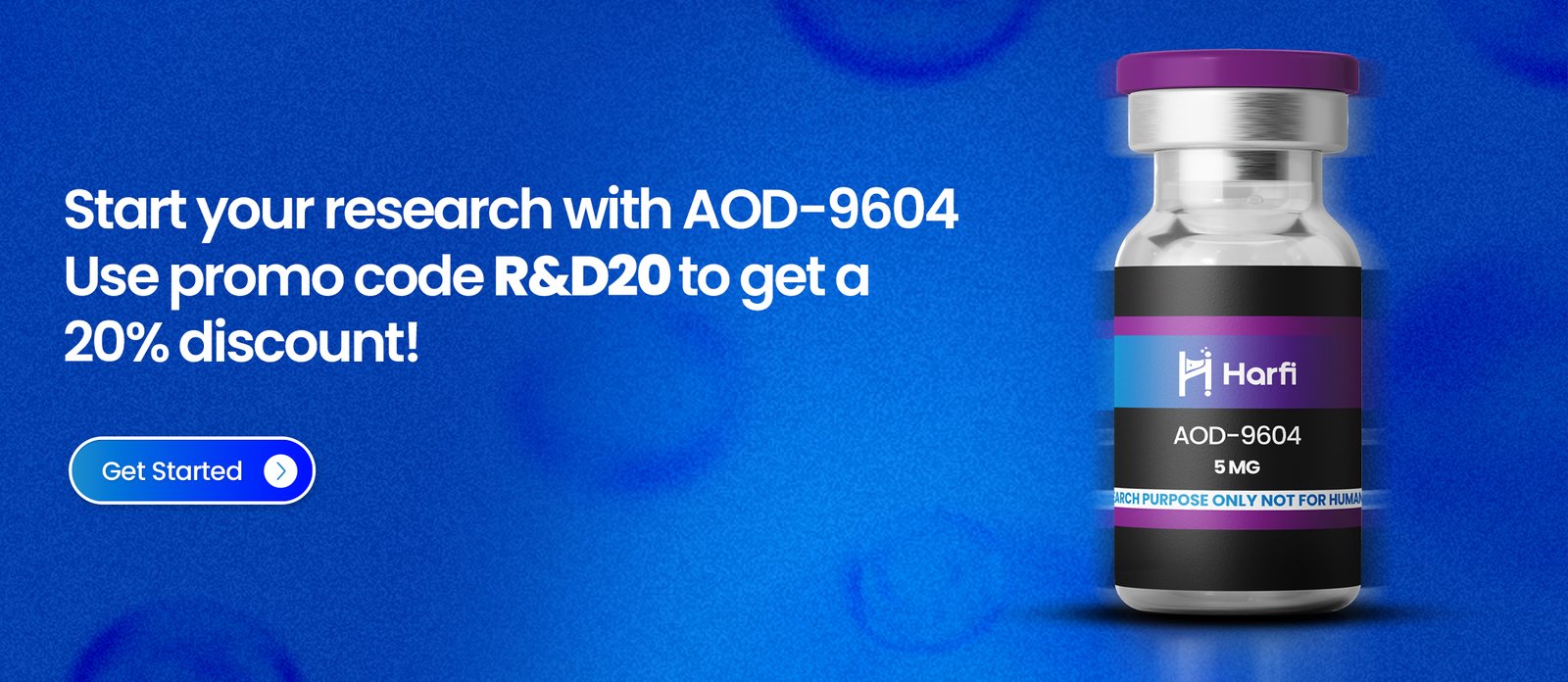AOD9604
AOD9604 is a modified peptide derived from the human growth hormone (hGH) fragment 176-191, featuring a di-sulfide bridge modification. Originally developed for its fat-burning (lipolytic) properties, AOD9604 has shown potential in research related to heart disease, osteoarthritis, and metabolic syndrome. Studies in animals suggest that AOD9604 enhances lipolysis (fat breakdown) while also inhibiting lipogenesis (fat formation).
Product Usage
This product is intended for research purposes only. It is strictly designated for in vitro testing and laboratory experimentation. All information provided on this website is for educational purposes only. Any introduction into humans or animals is strictly prohibited by law. Only licensed, qualified professionals should handle this product. It is not a drug, food, or cosmetic and must not be misbranded, misused, or mislabeled as such.
Introduction
AOD9604, derived from fragment 176-191—a modified segment of human growth hormone (HGH)—was originally developed for its fat-burning (lipolytic) properties as a potential anti-obesity treatment. What makes this peptide unique is its selective action on fat reduction without significantly affecting other physiological processes. Notably, AOD9604 does not appear to impact IGF-1 or insulin levels, reducing the risk of glucose intolerance or diabetes. Additionally, due to its structural similarity to HGH, it does not seem to trigger an immune response or lead to antibody formation.
AOD-9604:- AOD-9604 must be reconstituted with acetic acid 4:1 ratio
Structure
Sequence: Tyr-Leu-Arg-Ile-Val-Gln-Cys-Arg-Ser-Val-Glu-Gly-Ser-Cys-Gly-Phe Disulfide bridge Cys7-Cys15
Molecular Formula: C78H123N23O23S2
Molecular Weigh: 1815.12 g/mol
PubChem CID: 16131447
CAS Number: 386264-39-7

Research
AOD9604 and Obesity
AOD9604 was initially developed as an HGH analogue specifically targeting fat reduction. In Australia, Phase 2b clinical trials involving 300 obese participants demonstrated that a 12-week daily regimen of AOD9604 resulted in three times the weight loss compared to a placebo. Notably, the rate of weight loss remained steady throughout the trial, indicating that resistance to the peptide is unlikely to develop, and prolonged treatment could lead to even greater weight reduction.
Research in genetically obese mice suggests that AOD9604’s fat-burning effects extend beyond its interaction with beta-3-adrenergic receptors in white fat. Initially, scientists believed that the peptide activated these receptors, enhancing metabolism and shifting fat cells from storage to energy utilization. However, studies show that fat loss continues to occur even in mice lacking these receptors when treated with AOD9604, implying the involvement of additional mechanisms. Some hypotheses suggest that AOD9604 may indirectly induce apoptosis, or programmed cell death, in white fat cells, contributing to its fat-reducing properties.

Joint Pain and Function
Studies in rats indicate that direct injections of AOD9604 into arthritic joints can enhance pain management, reduce disability, and improve overall quality of life. Clinical observations and microscopic analyses of cartilage suggest that AOD9604 effectively targets the underlying causes of osteoarthritis. This peptide may serve as both a treatment and a preventive measure. While AOD9604 independently alleviates joint dysfunction, its effectiveness increases when combined with other therapies. Although the precise mechanisms behind this synergy remain unclear, further research could uncover new pathways for promoting cartilage growth—a persistent challenge in clinical treatment.
AOD9604 and Heart Disease
Although primarily recognized for its fat-reducing properties, AOD9604 may also offer cardiovascular benefits beyond weight loss. Preliminary findings suggest that the peptide could influence metabolism in ways that help reduce heart-related complications independent of obesity. This idea is not without precedent, as medications like pioglitazone and acipimox have demonstrated the ability to address metabolic issues without directly targeting obesity. It is believed that AOD9604’s unique fat-reducing mechanism—distinct from beta-3-adrenergic receptor activation—may contribute to improved metabolic health while simultaneously supporting fat loss.
DISCLAIMER: FOR INFORMATIONAL AND EDUCATIONAL PURPOSES ONLY
All articles and product details provided on this website are strictly for informational and educational purposes.
The product information presented here applies solely to in-vitro studies—experiments conducted outside of living organisms, such as in laboratory settings. These products are not classified as medicines or drugs and have not been approved by the FDA for the prevention, treatment, or cure of any medical conditions, ailments, or diseases.
Furthermore, the use of these products in humans or animals is strictly prohibited by law.

